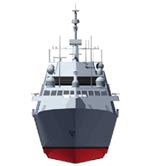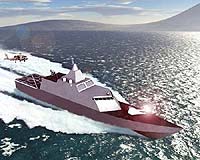US Navy Secretary's visit to India to maintain momentum of high profile exchanges
25 Mar 2008
New Delhi: US Navy secretary, Donald Winter, will arrive in India on Wednesday on a visit that will see him visiting key defence establishments at New Delhi and Mumbai. Secretary Winter arrives here from Israel, where he is currently on a three-day visit. His visit here begins even as Indian external affairs minister Pranab Mukherjee winds up an important visit to the United States.
The US Navy secretary's visit is expected to maintain the momentum of high profile visits and exchanges that the two countries have been conducting for some time now. Defence secretary Robert Gates concluded a visit only recently.
In India secretary Winter is expected to visit the headquarters of the Western Naval Command at Mumbai, and also the Navy's shipbuilding facility based here at the Mazgaon Docks (MDL). In New Delhi, he will visit the Indian Navy's Maritime Operations Centre and the headquarters of the Defence Research and Development Organization.
His visit comes in the backdrop of current controversy related to the purchase by the Indian Navy of a former US Navy amphibious transport dock USS Trenton (re-designated INS Jalashwa) which experienced a fatal accident last month, killing six sailors.
Also, an Indian government audit report, released on 14 March, severely criticizes the 2007 purchase of the ship.
Interestingly, Secretary Winter ongoing visit to Israel may see him discussing the sale of the Littoral Combat Ship (LCS) to that country, for which the Israeli's have long expressed an interest.
In April 2005, the US Navy awarded a foreign military sales contract to Lockheed Martin to conduct a nine-month feasibility study to examine possible modifications for an Israeli version of the Lockheed Martin LCS under construction for the US Navy (LCS-1-USS Freedom).
The study has focused on hull, mechanical and electrical system compatibility, along with an Israeli Navy requirement for the Mk41 vertical-launch system for Barak missiles. The contract was extended in November 2007 to include technical specification sand costs for the combat system.
The Israeli version may be a more heavily armed LCS design than the US Navy original.
It may be pertinent to point out here that Lockheed Martin has offered to build three surface combat ships for the Indian Navy. Though the type of ships have not been specified, it could easily be the LCS as some production lines at the Mazgaon Docks are lying idle, awaiting fresh orders from the Indian Navy.
Though the LCS will be a corvette size ship, smaller in size than the larger combat ships that the yards can handle, the advantage is that production lines can be activated. For that matter, the orders could easily go to other yards, such as the one at Goa, which has traditionally constructed corvette size ships for the Indian Navy.
The Israeli requirement for launchers for the Barak missile system finds commonality with Indian Navy ships as well, or they too deploy the Israeli system.
Another possible advantage for the Navy would lie in the modular type of construction that the LCS allows, which will see a larger turnover of ships at the yard. The Indian Navy has been trying desperately to enhance its fleet size for quite some time, trying to overcome a historical legacy when the yards sat idle for almost a decade awaiting orders from the government.
In terms of operational profile, the LCS may also fit in well with the Navy's need to maintain watch over a host of littoral countries in the region, even as it deploys its main assets for long-range operations.
The Israeli version could well become a joint Indo-Israeli version leading to a larger order for Lockheed. This would also favourably impact the economics of the project, for larger orders bring down prices.
Since the US Navy itself has a fairly large requirement for the LCS ( 55-60 ships), it is likely that Indian yards may supply parts and material for the US Navy and other orders as well.
On his visit to Israel, Secretary Winter is expected to visit the Haifa Naval Base, Israeli Naval Forces Headquarters, the Ministry of Defense, Plasan Sasa Industries, Israel Aerospace Industries and the Yad Vashem Holocaust Memorial.
From India, Secretary Winter will travel to Spain, where he will also visit the Navantia Shipyard facility in El Ferrol.
Littoral Combat Ship (LCS) The Littoral Combat Ship (LCS) is the first of a new generation of fast, highly manoeuvrable and networked surface combat ships for the US Navy. They will be a specialised version of a family of US future surface combat ships known as DD(X).
The Littoral Combat Ship (LCS) is the first of a new generation of fast, highly manoeuvrable and networked surface combat ships for the US Navy. They will be a specialised version of a family of US future surface combat ships known as DD(X).
The LCS will be a shallow draft vessel that will operate in the littoral (coastal) waters. They are designed to counter growing potential 'asymmetric' threats of coastal mines, quiet diesel submarines and terrorists operating on small, fast, armed boats.
In May 2004, the United States Department of Defence and the US Navy announced the selection of two separate defence contracting teams led by Lockheed Martin and General Dynamics which would carry out detailed design and construction of two Flight 0, or first generation, LCS ships.
Lockheed Martin's first ship, LCS 1, USS Freedom, is scheduled to commission in autumn 2008. It will be based at San Diego.
General Dynamics' first ship LCS 2, USS Independence, will launch in 2008 and commission in 2009.
Orders are expected to be placed for nine Flight 1 (second-generation) LCS ships during 2008 and 2009, for commissioning in the period 2010 -12.
LCS Design  Both the Lockheed and General Dynamics design achieve sprint speeds of over 40kt and long-range transit distances of over 3,500 miles. The Lockheed Martin design is a high-speed semi-planing mono-hull. The General Dynamics design is a tri-maran with a slender stabilised mono-hull.
Both the Lockheed and General Dynamics design achieve sprint speeds of over 40kt and long-range transit distances of over 3,500 miles. The Lockheed Martin design is a high-speed semi-planing mono-hull. The General Dynamics design is a tri-maran with a slender stabilised mono-hull.
In both designs, the sprint speed of 40kt to 50 kt results in the body of the hull being lifted out of the water as much as possible.
The shaping of the hull in both design strategies gives signature reduction. The designs of both ships continue to evolve with changes in the design proposals.
LCS Capabilities
A full load displacement draft of 10ft allows the ships to access very shallow, coastal waters. At a top speed of about 50kt the range is 1,500nm, while at an economical speed of 20kt, the range is 4,300nm.
The ships are configured with a helicopter deck and hangar, which can handle the launch and recovery of a MH-60R/S sized helicopter and a tactical unmanned air vehicle.
The ships will carry provisions for 21 days before replenishments and will carry a crew size of between 15 and 50 personnel. Accommodation will be available for up to 75 ship and special mission crew.
The operational availability will be 95 per cent.
Mission packages will include: Mine Warfare (MIW), Anti-Submarine Warfare (ASW) and Anti-Surface Warfare (SUW). The mission modules can be changed, tested and made operational within 24 hours.
Northrop Grumman has been appointed as mission package integrator.
The mission modules may be integrated into standard-sized containers that can be installed in the ship and will be connected to other surface ships and aircraft.
Both General Dynamics and Lockheed Martin vessels are armed with BAE Systems Land and Armaments Mk110 57mm naval gun system, which fires ammunition at a rate of 220 rounds a minute to a range of 14km (nine miles).
Lockheed Martin Semi-Planing Monohull
Lockheed Martin's advanced semi-planing seaframe is based on technologies introduced by Italian shipbuilder Fincantieri on the Destrier commercial vessel, which holds the transatlantic speed record.
The ship has a steel hull with aluminum superstructure and will be powered by two Rolls-Royce MT30 36MW gas turbines and two Fairbanks Morse Colt-Pielstick 16PA6B STC diesel engines driving four large, acoustically optimised Rolls-Royce water jets.
The ship's maximum speed is 45kt.
The vessel has automated stern doors, stern ramp, side launch doors and overhead crane for the launch and recovery of manned and unmanned vessels.






















